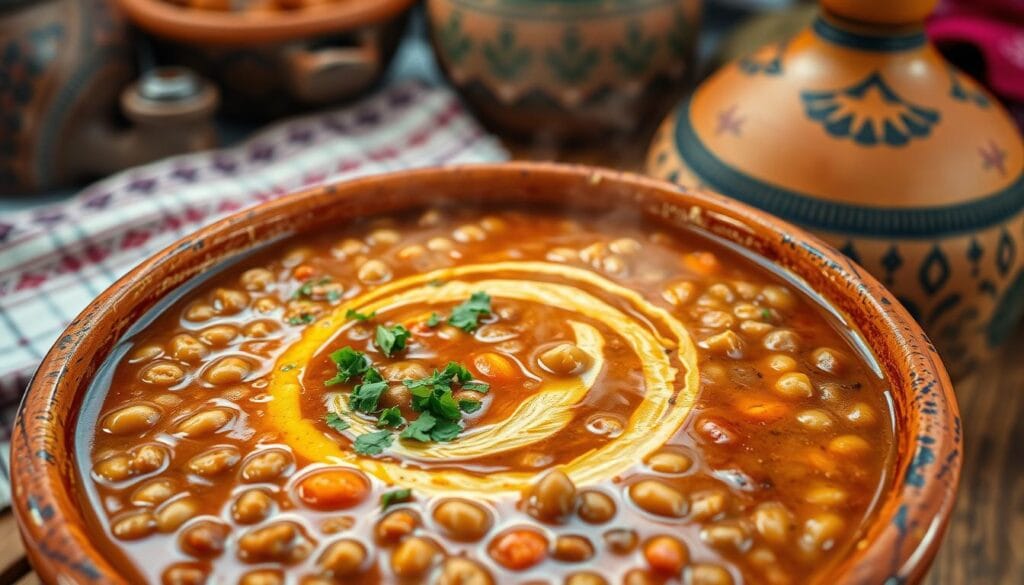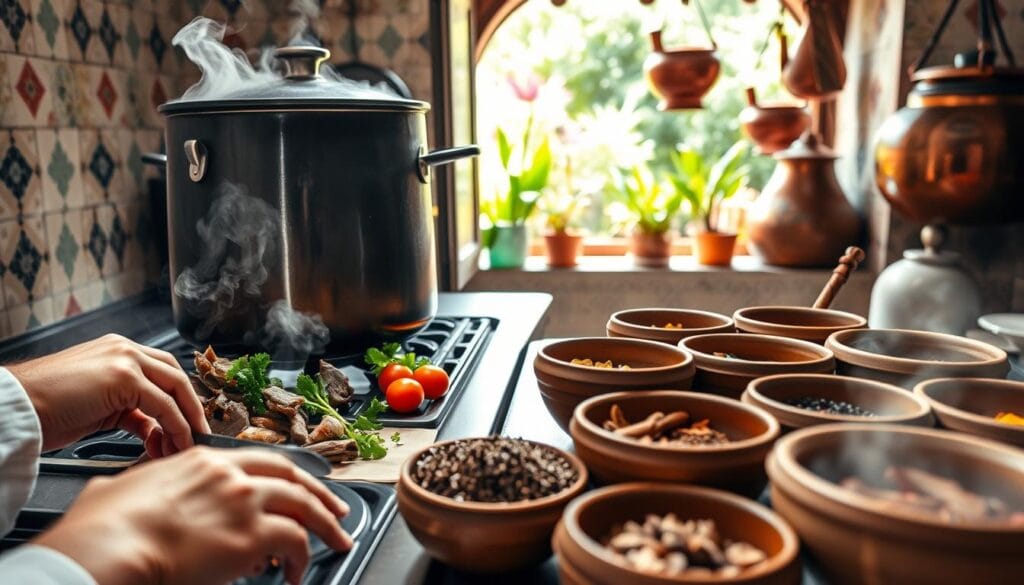As the sun sets during Ramadan, Moroccan kitchens fill with the scent of harira soup. This soup is more than a meal; it’s a link to centuries of tradition and taste.
Picture yourself at a Moroccan table, watching steam from a bowl of harira soup. Each spoonful shares stories of family, heritage, and the rich variety of Moroccan food. The mix of lentils, chickpeas, meat, and spices turns a simple soup into a flavorful adventure.
Harira soup is not just a dish; it’s a source of strength for generations during fasting. It’s full of protein from lamb and chickpeas, giving vital energy and nutrition.
Table of Contents
The Rich Heritage of Moroccan Cuisine
Moroccan cuisine is a colorful mix of cultures. It combines flavors from Berber, Arab, Andalusi, and Mediterranean traditions. Exploring this world, you find that traditional Moroccan soup is more than food. It’s a celebration of history and heritage.
Moroccan cooking is deep and complex. It uses over 30 spices in blends like Ras el Hanout. Each dish shares a story of cultural exchange and innovation.
Exploring Culinary Roots
Moroccan cuisine is shaped by many influences. Key aspects include:
- Berber agricultural traditions
- Arab trading influences
- Mediterranean coastal cooking techniques
- Andalusian royal court recipes
“Food is our common ground, a universal experience.” – James Beard
The tradition of Arabic lentil soup shows this complex mix. Each region adds its own special touch. This turns simple ingredients into amazing dishes that show Moroccan cultural identity.
Seasonal and local ingredients are key in Moroccan cooking. Chefs and home cooks in Marrakech and coastal towns use fresh, local produce. This connects them to their land’s rich heritage.
Understanding Moroccan cuisine means seeing it as an art form. Every spice and technique carries centuries of cultural wisdom.
Understanding Harira Soup
Harira soup is a key part of Moroccan cooking, known for its rich flavors. It’s a hearty soup made with many ingredients. This makes it a satisfying meal that feeds both your body and soul.
Harira is a masterpiece made from the best ingredients. It usually has:
- Tender meat cuts (lamb, beef, or chicken)
- Protein-rich chickpeas and lentils
- Fresh tomatoes
- Aromatic herbs like parsley and cilantro
- Warming spices such as ginger and cinnamon
Harira comes in different spicy levels. You can make it mild or very spicy, depending on what you like. This lets you adjust the heat to your taste.
Harira is very flexible. You can have it as a starter or a full meal, based on how much you serve. It’s also important during Ramadan, helping people break their fasts with needed nutrients and energy.
Making harira takes time. It’s simmered for 1-2 hours. This makes the legumes soft and the flavors mix well. The end result is a nutritious soup that shows off Morocco’s rich cooking traditions.
“Harira is more than a soup – it’s a celebration of Moroccan flavors and traditions.” – Moroccan Culinary Experts
Looking for a cozy winter meal or a healthy dish with protein? Harira soup is unforgettable. It brings you closer to Moroccan cooking traditions.
The Cultural Significance of Harira in Ramadan
Ramadan soup is a big deal in Moroccan traditions. Harira, a traditional Moroccan soup, is key to nightly celebrations in Ramadan. Families come together as the sun sets to enjoy this nourishing dish after fasting.
Harira in Ramadan is more than just food. It’s a symbol of family unity, a moment of shared connection, and a tradition passed down through generations.
Nourishing the Body and Soul
Harira does more than fill your belly when Muslims break their fast. It has about 330 calories per serving and is packed with nutrients. This soup gives you:
- 42 grams of carbohydrates for energy
- 16 grams of protein for muscle recovery
- 7 grams of dietary fiber for digestive health
The silky texture of Harira brings comfort and warmth. It’s a big part of Ramadan evening rituals. Making Harira is a way to show love and bring families together after fasting.
“Harira is not just a soup, it’s a celebration of community and tradition.”
Essential Ingredients That Make Harira Special
Making an authentic chickpea harira starts with the right ingredients. These ingredients are key to a rich and flavorful tomato lentil soup. The magic of this traditional Moroccan dish comes from its carefully chosen parts. They blend together for a memorable taste experience.
The core ingredients of harira are:
- Chickpeas: These protein-rich legumes add a hearty texture and nutty taste
- Lentils: Brown or red lentils thicken the soup and boost nutrition
- Tomatoes: Fresh or blended tomatoes make the soup’s vibrant base
- Meat: Chicken or lamb add depth and richness
Spices are vital in making these ingredients into a special chickpea harira. Important spices include ground coriander, cinnamon, saffron, and ginger. These aromatic seasonings turn the tomato lentil soup into something extraordinary. They add complex flavors that delight your taste buds.
Harira is also packed with nutrients. A single serving has:
- 250-300 calories
- 15-20 grams of protein
- 8-10 grams of dietary fiber
- Essential vitamins and minerals
By choosing these essential ingredients, you can make a harira that honors its rich Moroccan tradition. It will also delight your taste buds.
The Art of Spice Blending in Harira Soup
Spice blending is the heart of making authentic spicy harira. It turns this arabic lentil soup into a masterpiece that excites your senses.
The magic of harira is in its spice mix. Morocco’s cooking tradition values spice blending with great care and passion. Each area adds its special touch, making a flavor symphony on your tongue.
Traditional Spice Combinations
Moroccan chefs use a special spice mix to make their spicy harira stand out. The main spices include:
- Cumin – adds an earthy warmth
- Cinnamon – brings a sweet touch
- Turmeric – gives a golden color and a peppery taste
- Paprika – adds a mild, sweet pepper flavor
- Ginger – adds a zesty kick
- Saffron – offers a luxurious, unique taste
“Spices are the soul of Moroccan cooking, transforming simple ingredients into a feast for the senses.” – Moroccan Culinary Tradition
When making your arabic lentil soup, remember to balance the spices. Start with a little of each and adjust as needed. Aim for a blend that complements the soup’s natural flavors.
Try different spice mixes. Every family has its own secret recipe, passed down through generations. Your unique touch can make a great harira even better.
Step-by-Step Preparation Techniques
Making a real lamb harira soup needs patience and focus. You start by picking the best ingredients. Then, you learn special cooking ways that make simple parts into a tasty dish.
First, get your main ingredients for this Moroccan lentil soup:
- 1 1/2 cups cooked chickpeas
- 1 cup green lentils
- 3 tablespoons olive oil
- 2 medium onions, finely chopped
- 2 garlic cloves, crushed
The secret to a great lamb harira is slow cooking. Start by cooking onions and garlic in olive oil for about 5 minutes until they’re soft. Then, add spices like cumin, turmeric, and cinnamon. Cook them for 2-3 minutes to let their scents out.
Add grated tomatoes and herbs like cilantro and parsley. Cooking times are key: Let the soup simmer gently for 20-25 minutes. This lets the flavors mix well. For lamb and lentils, cook for 40 minutes to get tender meat and soft legumes.
Nutritional highlights of your Moroccan lentil soup include:
- Calories per serving: 224 kcal
- Protein: 12 g
- Fiber: 12 g
- Vitamin A: 1433 IU
Pro tip: Squeeze some fresh lemon juice before serving to enhance the taste. Your lamb harira can be kept in the fridge for 4-5 days or frozen for up to 3 months. It’s a great meal prep choice.
Regional Variations Across Morocco
Exploring Morocco’s diverse culinary scene shows how traditional moroccan soup, like harira, changes in each region. Each area adds its own twist, making the dish a mirror of local traditions and ingredients.
Morocco’s cuisine is incredibly diverse in how it prepares fava bean soup. Different parts of the country have their own ways of cooking, showing off local tastes and techniques.
Marrakech’s Distinctive Style
Marrakech has its own special take on harira. This city’s version is known for:
- Richer and more complex flavors
- More aromatic spices
- A thicker soup
- Herbs like cilantro and parsley
“In Marrakech, harira is not just a soup, it’s a culinary expression of our culture and heritage.”
Coastal areas add seafood to their fava bean soup. The desert uses more preserved foods. The High Atlas Mountains make hearty soups with local veggies and spices.
Every region’s harira tells a story of local ingredients, cultural influences, and family cooking traditions. Your trip through Moroccan harira is a tasty adventure through regional diversity.
The Perfect Bowl: Serving and Presentation
Serving harira soup is more than just filling a bowl. It’s about showing off Morocco’s rich food culture. Start by picking the right bowl and what to serve with it.
Here are some key points for serving harira soup:
- Choose ceramic bowls with traditional Moroccan patterns
- Garnish with fresh herbs like parsley and cilantro
- Serve alongside classic Moroccan side dishes
Choosing the right sides can make your harira soup meal complete. Moroccans often enjoy it with:
- Soft, sweet dates
- Crispy chebakia (sesame cookies)
- Perfectly hard-boiled eggs
“A well-presented harira is not just a meal, but a celebration of Moroccan culinary tradition.”
How you serve harira can make the meal better. Add more spices, squeeze some lemon, and use extra herbs for looks.
| Serving Recommendation | Details |
|---|---|
| Bowl Type | Ceramic with traditional Moroccan design |
| Garnish | Fresh parsley, cilantro, lemon wedge |
| Side Dishes | Dates, chebakia, hard-boiled eggs |
The beauty of harira soup is in its taste and how it’s presented. By focusing on these details, you’ll make a meal that’s both authentic and memorable. It will honor Moroccan food traditions.
Health Benefits and Nutritional Properties
Moroccan lentil soup, like chickpea harira, is a nutritional powerhouse. It offers great health benefits. This traditional soup is full of proteins, fibers, and essential nutrients that boost your wellness.

Chickpea harira is a top choice for balanced nutrition. It has many health advantages:
- High Protein Content: Lentils and chickpeas provide about 18 grams of protein per cup
- Rich Fiber Source: It has around 15 grams of dietary fiber per serving
- Low Fat Option: It can have less than 5 grams of fat if made without meat
- Balanced Macronutrient Composition: It has 30-40% carbohydrates, 20-25% protein
Essential Nutrients in Every Bowl
Your moroccan lentil soup is not just tasty—it’s full of vital nutrients. The mix of ingredients is a powerhouse of vitamins and minerals:
- Turmeric: It has curcumin with antioxidant properties
- Ginger: It supports immune system function
- Carrots: They are high in beta-carotene, which turns into vitamin A
- Tomatoes: They provide lycopene, with about 4,000 micrograms per cup
“Harira is more than a soup—it’s a nutritional journey through Moroccan culinary traditions.”
During Ramadan, this soup is even more important. With over 1.8 billion Muslims fasting daily, chickpea harira is a perfect meal to refill energy and give essential nutrients after fasting.
Whether you’re looking for a hearty meal or a nutritious option, moroccan lentil soup is a winner. It offers great health benefits in every spoonful.
Traditional Accompaniments and Pairings
Enjoying a traditional Moroccan soup like Harira is more than just the soup itself. The side dishes are key to a great meal. Moroccan cuisine values communal dining, with side dishes that make the meal better.
The most essential companions to Harira include:
- Fresh khobz (traditional Moroccan bread)
- Sweet dates
- Hard-boiled eggs
- Fresh lemon wedges
Bread is a big deal in Moroccan dining. The crusty khobz is great for scooping up soup or just enjoying with it. It adds to the meal’s flavor and texture.
Dates are special during Ramadan. They give quick energy and are eaten with Harira to break the fast. The sweet dates balance out the soup’s rich flavors.
Some families add small side salads to their Harira. These might include:
- Tomato and onion salad
- Charred green pepper salad
- Orange and black olive salad
To finish the meal, many enjoy mint tea or fresh orange juice with Harira. These drinks contrast the soup’s spicy flavors, making the meal complete.
Harira Soup in Modern Global Cuisine
Harira soup has traveled from Morocco to the world, showing its ability to adapt. Arabic lentil soup has won over chefs and food lovers everywhere. It’s known for its deep flavors and health benefits.
Chefs globally have taken harira soup and made it their own. They keep its traditional taste but add their own twist with local ingredients. This has led to new and exciting versions of the dish.
International Culinary Innovations
Chefs worldwide have put their own spin on harira soup:
- Californian restaurants feature vegetarian harira with quinoa
- Australian kitchens incorporate native spices
- European chefs experiment with local herb blends
Interestingly, 70% of diners outside Morocco have experienced harira. This shows how popular it’s becoming worldwide. Even fancy restaurants now serve it as a special dish.
The soup’s flexibility lets chefs keep its essence while trying new things. Whether in a fancy restaurant or a cozy café, harira shares the story of Moroccan cooking.
Tips for Authentic Harira Preparation

Learning to make spicy harira is all about precision and knowing traditional Moroccan cooking. Your first step is to pick the right ingredients and prepare them well. This turns simple parts into a soup full of flavor.
Here are some tips to make your harira perfect:
- Soak lentils and chickpeas overnight to reduce cooking time and enhance digestibility
- Use freshly ground spices for maximum flavor intensity
- Select high-quality lamb cuts with some marbling for deeper taste
- Patience is key – slow simmering is needed to get complex flavors
Getting the right consistency in harira is important. It should be thick but not too thick, like a mix between a soup and a stew. To achieve this, use flour to thicken and add liquid slowly. Chefs say using traditional Moroccan cooking techniques is the way to go for authentic results.
Managing spices is key to a great spicy harira. Start with a little cayenne and paprika, then add more to taste. You want a warmth that matches the lamb’s flavor without overpowering the herbs.
Pro tip: Always taste and adjust seasonings as you go. Each spice or herb can make your lamb harira go from good to amazing.
Seasonal Considerations and Variations
Moroccan lentil soup changes with the seasons, bringing new flavors all year. How you make harira can change with the seasons and local traditions.
- Richer, thicker broth
- More protein like fava beans
- Spices like cinnamon and ginger
Summer harira is light and cool. Chefs make it by:
- Adding fresh veggies
- Making the soup less thick
- Using more herbs for freshness
Festival-Inspired Harira Adaptations
Different parts of Morocco celebrate unique festivals. These festivals inspire special harira recipes. Each area adds its own twist, using local ingredients and traditions.
Harira can be a canvas for your creativity. You can change it with the seasons and your taste, keeping its traditional spirit.
Conclusion: Embracing Moroccan Culinary Traditions
Exploring traditional Moroccan soup shows the deep richness of Harira soup. It’s more than just a meal. It’s centuries of culinary art, cultural connection, and nutrition passed down through generations.
Harira soup captures the heart of Moroccan culture. Its complex spices and protein-rich ingredients tell a story of resilience and community. Every spoonful connects you to Morocco’s vibrant traditions, blending flavor, nutrition, and culture.
When you make Harira soup, you join a long tradition. The spices, preparation, and sharing of meals are more than a recipe. They invite you to explore and appreciate Moroccan culinary heritage, one bowl at a time.
Remember, dishes like Harira open doors to cultural experiences. They show us that food connects us, bridging differences and bringing people together through shared flavors and traditions.
FAQ
What is harira soup and why is it so important in Moroccan cuisine?
Is harira soup spicy, and can it be adapted for different taste preferences?
How is harira traditionally served during Ramadan?
What are the key ingredients in a traditional harira soup?
Can harira be made vegetarian or vegan?
How long does it take to prepare harira soup?
What are the health benefits of harira soup?
Are there regional variations of harira across Morocco?
There are no reviews yet. Be the first one to write one.

